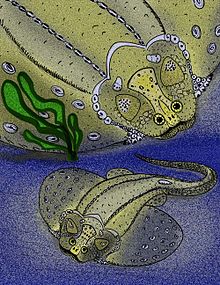Rhenanida: Difference between revisions
Apokryltaros (talk | contribs) No edit summary |
GrahamBould (talk | contribs) mNo edit summary |
||
| Line 34: | Line 34: | ||
==References== |
==References== |
||
* [http://www.palaeos.com/Vertebrates/Units/Unit060/060.100.html#Rhenanida Paleos Rhenanida] |
|||
== References == |
== References == |
||
| ⚫ | |||
| ⚫ | |||
[[Category:Prehistoric fish]] |
[[Category:Prehistoric fish]] |
||
| Line 45: | Line 44: | ||
[[Category:Devonian fish]] |
[[Category:Devonian fish]] |
||
{{paleo-stub}} |
|||
{{fish-stub}} |
{{fish-stub}} |
||
Revision as of 17:27, 16 November 2006
| Rhenanida | |
|---|---|

| |
Fossil
| |
| Scientific classification | |
| Kingdom: | |
| Phylum: | |
| Subphylum: | |
| Infraphylum: | |
| Class: | |
| Order: | Rhenanida †
|
| Family: | |
| Genus | |
|
?Ohioaspis † | |
Rhenanida ("Rhine (fish)") was an order of primitive, lightly armored (relatively speaking) placoderms. Unlike most other placoderms, the rhenanids' armor was made up of a mosaic of unfused scales and tubercles. This "mosaic" corresponds to the plates of armor in other, more advanced placoderms, suggesting that the ancestral placoderm had armor made of unfused components, as well.
All rhenanids were flattened, ray-like, bottom-dwelling predators or shellfish-eaters that lived in marine environments.
The rhenanids were once presumed to be the most primitive, or at least the closest to the ancestral placoderm, as their armor was made up of a mosaic of tubercles, as opposed to the solidified plates of "advanced" placoderms, such as antiarchs and arthrodires. Through comparing the skull anatomies of Jagorina pandora with those of antiarchs, the rhenanids are considered to be the sister group of the antiarchs.
Rhenanida's fossil record is very sparse, with most fossils being isolated tubercles that are identified as being similar to the tubercles from the armor of Gemuendina stuertzi, the most well-known rhenanid. Given the rhenanids' worldwide distribution, this paupacity probably did not reflect a scarcity of living indivuals (when they were alive), but reflects the fact that rhenanid armor disintegrated into isolated fragments, and scattered soon after the owner's demise. Most fossils of rhenanids are from the Early Devonian, primarily in the United States and Germany. The youngest known (and last) species of rhenanid was Bolivosteus chacomensis, of the Mid Devonian Malvinokaffric Fauna of Western Gondwana, in what is now Bolivia, South America.
There are four recognized species of rhenanids, in four genera, Asterosteus stenocephalus, Gemuendina stuertzi, Jagorina pandora, and Bolivosteus chacomensis.
A fifth genus, Ohioaspis, is of questionable status, as the first specimens were originally described as being tubercles from a new species of Asterosteus, while later examinations have led to the formation of two camps of experts, one of which that believe the three recognized species of Ohioaspis were rhenanids, while the other suggests that they were actually some sort of ostracoderm agnathans
References
References
- Long, John A. The Rise of Fishes: 500 Million Years of Evolution Baltimore: The John Hopkins University Press, 1996. ISBN 0-8018-5438-5
